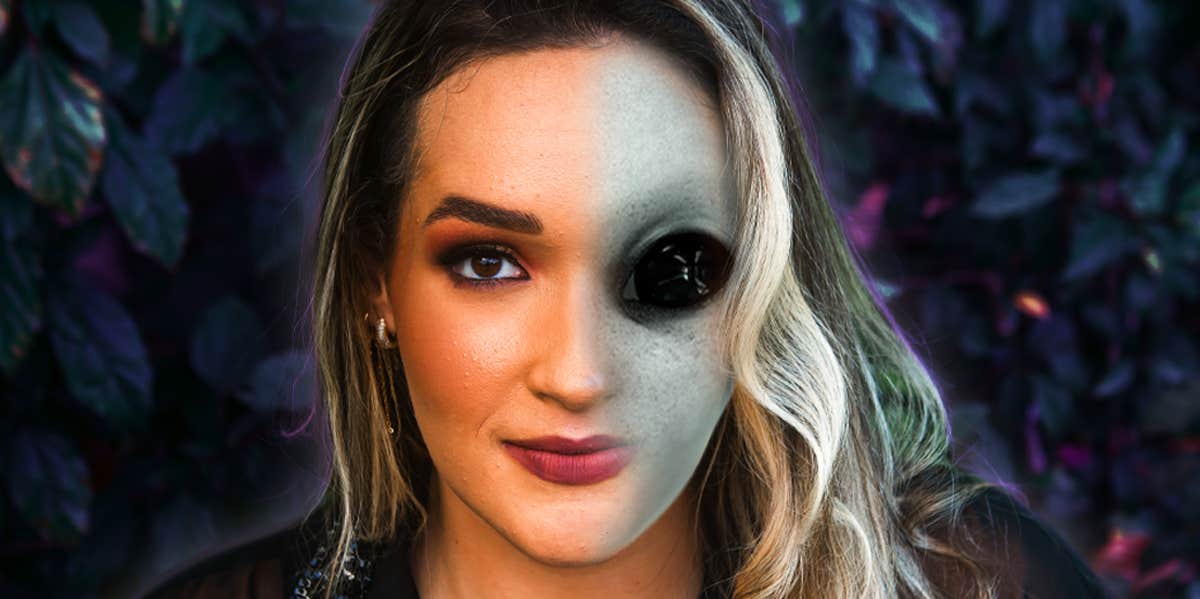The Freaky Visual Illusion That Makes Human Faces Look Like Aliens
Your mind is playing tricks on you.
 Pavel Chagochkin, Wigdston Soares / Shutterstock
Pavel Chagochkin, Wigdston Soares / Shutterstock The human mind is one of the most magnificent creations ever made. It performs magical feats and is a complex "machine" that scientists and psychologists are constantly trying to figure out.
When it comes to what we see, our eyes help to make decisions about and navigate the world around us, even when information is limited.
Whether we see things head-on or pick them up in our peripheral field of vision, the eyes communicate with the brain to make sense of what we have viewed.
This can result in optical illusions, seeing things that may not really be there. One of the scientific phenomena where this happens is known as the flashed face distortion effect.
This flashed face distortion effect optical illusion transforms people's faces into creepy-looking aliens.
To get a feel for how the visual trick works, Dr. Steve Rathje posted a TikTok video explaining:
Rathje describes the optical illusion as “a bit scary” to prepare his viewers for what they are about to see.
He starts to share two headshots, evenly aligned with a cross or "plus" sign in between them. Viewers are instructed to stare at the cross in the middle, only seeing the faces in their peripheral vision.
The photos change in quick succession, giving you just a moment to view them. The seemingly normal images start to change very quickly as you stare at the space in between.
Rathje clarifies that the images have not been altered in any way. But without looking directly at them, they start to take on alien-like characteristics.
If you have seen perfectly normal faces transform into warped faces, you have just experienced the flashed face distortion effect.
What is the flashed face distortion effect?
According to Rathje, the flashed face distortion effect is “an example of how our brains fill in the gaps when it has limited information.” Research describes the phenomenon as "a striking visual illusion in which faces presented sequentially in peripheral vision begin to look increasingly grotesque after just a few faces have been presented."
Rathje went on to explain that because humans have “bad” peripheral vision, our brains are likely just noticing the differences in appearance from one person to the next and exaggerating them to make the faces “look like caricatures.”
The flashed face distortion effect first came to light when an undergraduate student was working to set up an experiment using a series of faces whose eyes were perfectly aligned.
The student noticed that as he flipped through the photos, they started to look weirdly distorted or deformed. This kicked off experiments to shed light on exactly what was happening as the photos were viewed.
Researchers found that how distorted the faces were all depended on how different they looked from the others presented in a set. For example, if a person had a large nose, its fullness was over-exaggerated.
They also noted that 4-5 faces per second was the ideal speed for achieving the most face adaptation in the images. Misalignment of the eyes from one picture to the next slowed or weakened the flashed face distortion effect.
Scientists also saw that a neutral face that followed a distorted face took on those deformities, and that performing the same process with just one face took longer for the images to transform in people’s minds.
Why do human faces look like aliens when experiencing this phenomenon?
The flashed face distortion effect is an example of scientific phenomenology, the study of a subjective experience. It is believed to be independent of our brain’s face perception functions.
The effect is thought to be a result of our cortical (outer layer of the cerebrum) function, rather than our retinas. So, instead of seeing the images visually, our brains are filling in the blanks, albeit in a scary way.
The most likely mechanisms for the phenomenon are the uncertainty of our peripheral vision, a lack of attention to the things we are not viewing head-on, and visual crowding effect where our eyes are trying to interpret too many things at once.
The distortion effect is not limited to faces either. Researchers have found that when done on circles, they appear elongated.
But scientists continue to search for a definitive answer on what makes our eyes play tricks on us.
NyRee Ausler is a writer from Seattle, Washington, and author of seven books. She covers lifestyle and entertainment and news, as well as navigating the workplace and social issues.
